Maximizing DTF Transfers: Understanding Heat Press Pressure

Maximizing DTF Transfers: Understanding Heat Press Pressure
Maintaining consistent pressure throughout the Direct to Film (DTF) transfer process is crucial for producing top-notch prints on fabrics. This article delves into the importance of consistent pressure, the obstacles it can present, and effective methods for addressing these obstacles. By providing practical tips, this cornerstone content combines theoretical understanding with practical implementation.
Key Takeaways:
| Key Point | Why It Matters |
|---|---|
| Importance of Uniform Pressure | Essential for high-quality DTF transfers. |
| Common Challenges | Highlights factors leading to uneven pressure application. |
| Practical Guides and Techniques | Offers actionable strategies for achieving ideal outcomes. |
| Tools for Uniform Pressure | Reviews tools and modifications to enhance pressure uniformity. |
Introduction
Direct to Film printing is revolutionizing textile customization. The essence of achieving consistent, high-quality prints lies in applying uniform pressure throughout the transfer process.
The Importance of Uniform Pressure in DTF Printing
Uniform pressure ensures that transfer films adhere evenly across textiles, resulting in vivid, durable prints.

Common Challenges in Achieving Uniform Pressure
Achieving uniform pressure during Direct to Film (DTF) transfers is crucial for high-quality print results. However, several challenges can arise in ensuring consistent pressure across the print area. These challenges include:
1. Inconsistent Temperature or Pressure: Variations in temperature or pressure during the transfer process can lead to uneven transfer results. It's essential to maintain consistent temperature and pressure to ensure the ink and adhesive bond correctly to the substrate.
2. Excessive Temperature or Pressure: Applying too much temperature or pressure can damage the substrate or the print. Finding the right balance is key to avoiding such issues.
3. Inadequate Dwell Time: Not allowing enough time for the transfer can result in incomplete ink and adhesive bonding. Adjusting the dwell time based on the thickness and type of substrate is necessary for achieving uniform pressure and successful transfers.
4. Improper Heat Press Settings: The success of DTF transfers heavily relies on accurate heat press settings, including temperature, pressure, and dwell time. Using the correct settings ensures uniform ink and adhesive application and a strong bond between the print and the substrate.
5. Equipment Maintenance: Regular maintenance of the heat press, including cleaning the platen and checking for any damage or wear, is crucial. A well-maintained heat press is more likely to provide consistent temperature and pressure.
6. Quality of Heat Press: The quality of the heat press itself can affect the ability to achieve uniform pressure. A high-quality heat press with accurate temperature and pressure controls is essential for consistent and high-quality DTF transfers.
7. Environmental Conditions: Factors such as humidity and temperature in the printing environment can affect the transfer process. Controlling these conditions to maintain stability is important for achieving uniform pressure.
By addressing these challenges through proper equipment maintenance, accurate heat press settings, and environmental control, it's possible to achieve uniform pressure in DTF transfers, leading to vibrant, durable prints.
Comprehensive DTF Transfer Guides and Techniques
DTF Printing Essentials: A Closer Look
Understanding the basics of DTF printing is the first step toward mastering uniform pressure.
Simple Heat Press Instructions
Correct heat press operation is crucial for applying pressure uniformly.
The Ultimate DTF Printing Blueprint
This guide details how uniform pressure affects DTF print quality, especially for budget-conscious brands.
Practical Demonstrations and Video Guides
In this step-by-step instructional video, viewers are guided through the process of pressing Direct to Film (DTF) transfers onto T-shirts. The video provides detailed print instructions, emphasizing the importance of a warm peel technique to ensure high-quality results.
Techniques and Tools for Uniform Pressure Application
To achieve uniform pressure application in Direct to Film (DTF) printing, several techniques and tools are essential. These methods ensure that the DTF transfers adhere properly to the fabric, resulting in high-quality prints. Here are some highlighted techniques and tools based on the provided sources:
1. Use of a Heat Press Pillow or Pad: For uniform pressure distribution during the transfer process, employing a heat press pillow or pad is recommended. This tool helps compensate for any unevenness or zippers/buttons on the garment, ensuring consistent pressure across the transfer area.
2. Pre-pressing the Garment: Pre-pressing the garment before applying the DTF transfer is crucial. This step removes any moisture from the fabric and ensures that wrinkles are eliminated, which can affect the pressure and adherence of the transfer.
3. Proper Heat Press Settings: Setting the heat press to the correct temperature, pressure, and time is vital. The recommended temperature range for DTF transfers is usually between 280 – 325 degrees Fahrenheit, with a pressure range of 30 – 60 PSI (medium to firm). It's important to follow the manufacturer's instructions for the specific DTF transfer being used.
4. Ensuring the Heat Press is in Good Condition: The condition of the heat press machine plays a significant role in achieving uniform pressure. The machine should be clean and in good working condition, with even heat and pressure distribution across the entire platen.
5. Manual Adjustment for Pressure: For those using a heat press with a manual knob for pressure adjustment, it's crucial to develop a sense of the right pressure level through experience. While there may not be an electronic way to control or see the pressure applied, understanding how to adjust the knob for the desired pressure is key.
6. Testing Different Levels: Performing tests at different levels of temperature and pressure can help determine the ideal settings for the specific DTF transfers and fabrics being used. This experimentation ensures the highest quality results and helps avoid issues such as ink bleeding or transfer brittleness.
Conclusion
Achieving uniform pressure in DTF printing is paramount for quality. We encourage experimentation with the techniques discussed, always aiming for excellence in every print.
For further exploration and support, direct your journey towards our comprehensive resources, where continuous learning and improvement in DTF printing await.
By navigating through this guide, readers will gain a well-rounded understanding of how to achieve uniform pressure for quality DTF transfers, empowered with theoretical knowledge, practical advice, visual content, and direct access to further resources.

